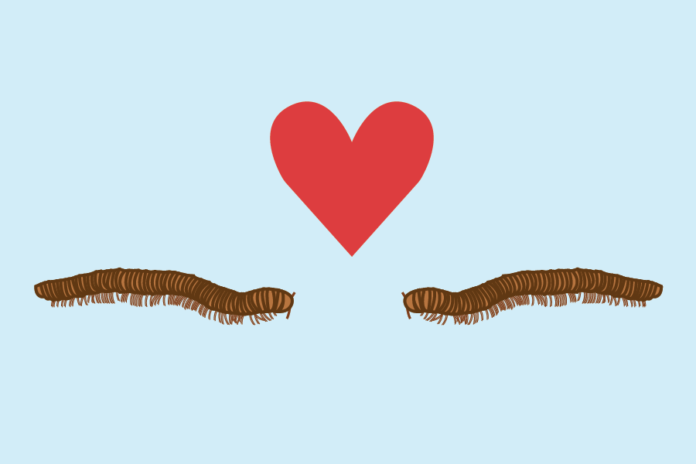3D modeling of millipedes reveals complex mating strategies
Scientists have finally uncovered the birds and the bees of millipedes. Millipede mating is a poorly understood topic in entomology, but a recent collaboration between UC Davis entomologists and the Field Museum of Natural History in Chicago reveals the intricate anatomy of millipedes.
Millipedes are an incredibly ancient group of arthropods, potentially among the first terrestrial animals in the fossil record. There are more than 12,000 species described so far and likely double that number exists but has not yet been discovered. Despite the long history of millipedes on Earth, there is still much to uncover about millipede diversity.
In current millepede research, most studies about mating and reproduction focus on the male side of the equation. Male millipedes begin life without any reproductive structures, but, as they molt, one pair of legs is absorbed into the body and later emerges as reproductive structures called gonopods. This incredibly complex procedure is fascinating to researchers because it is easy to observe, but this means not as much research has been conducted on female millipedes.
“Genitalic structures tend to be species-specific,” said Jason Bond, a professor of entomology in the department of entomology and nematology. “There’s a broader evolutionary question about how those structures evolved, why some millipedes have really complex genitalic structures and how genitalic structures fit together.”
To answer these questions, researchers used an imaging technology called micro-CT, similar to a CT scan of the brain. Micro-CT scanning is essentially a 3D X-ray. The millipede is rotated in a chamber while the scanner takes a series of 2D images. Then, a computer program compiles many cross-sectional images into a 3D model, all without harming the millipede.
“The computer program looks like a coloring book,” said Xavier Zahnle, a graduate student in the department of entomology and nematology. “You go layer by layer and fill in the areas you’re interested in. That’s how the computer knows to use those areas in the 3D image.”
After scanning the millipede, researchers made models of the reproductive organs they were interested in. Inside a single scan of a female millipede, the program can detect and distinguish parts of the body segments, legs and even individual glands within its organs. This technology makes it much easier to conduct in-depth studies of extremely tiny bug bodies.
“Twenty-five or 30 years ago, the only way to get this detailed information would have been to embed the specimen in wax and take slices through it,” Bond said. “Micro-CT essentially does that without damaging the specimen.”
Using micro-CT scanning, researchers constructed models and animations of millipede mating. They show each individual muscle, organ and exoskeleton segment moving together to reveal the mechanics of mating. These models answered questions about how millipedes accomplish their life cycle and, specifically, how females use different parts of their bodies to store sperm and eggs.
Researchers are able to see the structure of each organ and muscle through 3D modeling and hypothesize their possible functions. They found that a female millipede will invert her reproductive structures and push them out of the body to mate. She can then store sperm in structures called spermathecae, which are chambers separate from her eggs.
“Essentially, she checks off the requirement of ‘get sperm’ and saves it for later,” said Zahnle. “That allows her to wait it out until conditions are good. Then, she can lay her eggs and fertilize them externally.”
This strategy makes ecological sense according to a principle called differential investment. Egg cells are very large and require a lot of energy investment from the female, while sperm cells are small and are less energy-intensive to make.
“There’s a saying about that: eggs are expensive and sperm is cheap, in terms of how much energy each sex invests in making them,” Bond said.
Since females invest more energy into developing their eggs, they also tend to be choosier about their mates. The female is optimizing her offspring’s chance of survival by choosing the best male and waiting until the right time to lay eggs with the help of her unique reproductive structures.
One of the most exciting aspects of this research is that millipedes are not very well-studied, so there is a lot more to discover about them. In addition to new 3D data sets to better visualize their body shape and structure, researchers are diving into their genetics as well.
“With a lot of the millipede groups, the only thing we have to organize them is the anatomy and morphology, but we’re working on classifying them using genetics,” Zahnle said.
Zanhle also explained that millipedes are key components of healthy ecosystems. They are classified as detritivores, which are animals that eat dead plant material and return nutrients to the soil. Studying their reproductive strategies and population health could help scientists understand the role millipedes play in the larger environment.
“Detritivores are the custodians of the environment,” said Brennen Dyer, a junior specialist at the Bohart Museum of Entomology. “They recycle nutrients back into the ecosystem for other animals to use. That allows old dead things like trees to be broken down and recycled back into the soil.”
The researchers agree that millipedes play an essential role in the ecosystem, especially backyard habitats.
“They’re completely harmless and super friendly and good for your garden,” Zahnle said.
Written by: Lauren Glevanik — science@theaggie.org




